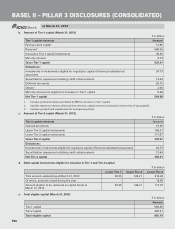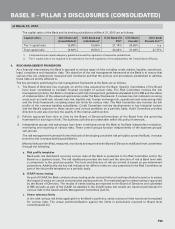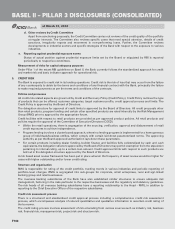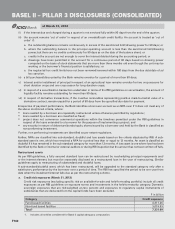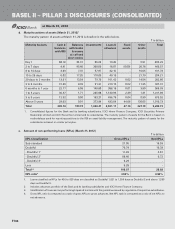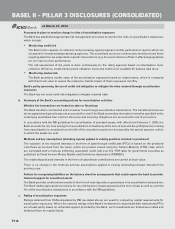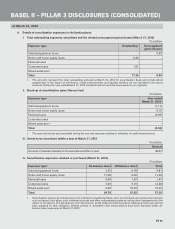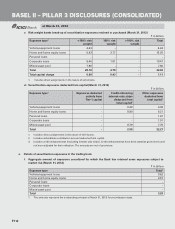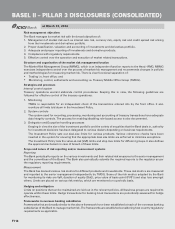ICICI Bank 2012 Annual Report Download - page 184
Download and view the complete annual report
Please find page 184 of the 2012 ICICI Bank annual report below. You can navigate through the pages in the report by either clicking on the pages listed below, or by using the keyword search tool below to find specific information within the annual report.
F106
II. As stipulated by RBI, the risk weights for resident corporate exposures are assessed based on the external ratings
assigned by domestic ECAI and the risk weights for non-resident corporate exposures are assessed based on the
external ratings assigned by international ECAI. For this purpose, at March 31, 2012, the domestic ECAI specified
by RBI were CRISIL Limited, Credit Analysis & Research Limited, ICRA Limited and Fitch India, and the international
ECAI specified by RBI were Standard & Poor’s, Moody’s and Fitch. Further, the RBI’s Basel II framework stipulates
guidelines on the scope and eligibility of application of external ratings. The Bank reckons the external rating on the
exposure for risk weighting purposes, if the external rating assessment complies with the guidelines stipulated by
RBI.
The key aspects of the Bank’s external ratings application framework are as follows:
The Bank uses only those ratings that have been solicited by the counterparty.
Foreign sovereign and foreign bank exposures are risk-weighted based on issuer ratings assigned to them.
The risk-weighting of corporate exposures based on the external credit ratings includes the following:
i. The Bank reckons external ratings of corporates either at the credit facility level or at the borrower (issuer)
level. The Bank considers the facility rating where both the facility and the borrower rating are available
given the more specific nature of the facility credit assessment.
ii. The Bank ensures that the external rating of the facility/borrower has been reviewed at least once by the
ECAI during the previous 15 months and is in force on the date of its application.
iii. When a borrower is assigned a rating that maps to a risk weight of 150%, then this rating is applied on all
the unrated facilities of the borrower and risk weighted at 150%.
iv. Unrated short-term claim on counterparty is assigned a risk weight of at least one level higher than the risk
weight applicable to the rated short term claim on that counterparty.
The RBI guidelines outline specific conditions for facilities that have multiple ratings. In this context, the lower
rating, where there are two ratings and the second-lowest rating where there are three or more ratings are used
for a given facility.
b. Credit exposures by risk weights
At March 31, 2012, the credit exposures subject to the Standardised approach after adjusting for credit risk
mitigation by risk weights were as follows:
` in billion
Exposure Category Amount outstanding1
Less than 100% risk weight 2,344.17
100% risk weight 4,312.72
More than 100% risk weight 507.66
Deducted from capital 24.35
Total27,188.90
1. Credit risk exposures include all exposures, as per RBI guidelines on exposure norms, subject to credit risk and investments
in held-to-maturity category. Claims on domestic sovereign which are risk-weighted at 0% and regulatory capital instruments
of subsidiaries, which are deducted from the capital funds have been excluded. The credit exposures have been adjusted for
credit risk mitigation.
2. Includes all entities considered for Basel II capital adequacy computation.
7. CREDIT RISK MITIGATION
a. Collateral management and credit risk mitigation
The Bank has a Board approved policy framework for collateral management and credit risk mitigation techniques,
which include among other aspects guidelines on acceptable types of collateral, ongoing monitoring of collateral
including the frequency and basis of valuation and application of credit risk mitigation techniques.
BASEL II – PILLAR 3 DISCLOSURES (CONSOLIDATED)
at March 31, 2012


